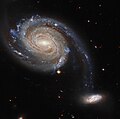Податотека:NGC7752, NGC7753 - HST - Potw2142a.jpg

Големина на овој преглед: 604 × 600 пиксели. Други разделности: 242 × 240 пиксели | 483 × 480 пиксели | 774 × 768 пиксели | 1.031 × 1.024 пиксели | 2.063 × 2.048 пиксели | 3.908 × 3.880 пиксели.
Изворна податотека (3.908 × 3.880 пиксели, големина: 3,2 МБ, MIME-тип: image/jpeg)
Историја на податотеката
Стиснете на датум/време за да ја видите податотеката како изгледала тогаш.
| Датум/време | Минијатура | Димензии | Корисник | Коментар | |
|---|---|---|---|---|---|
| тековна | 07:11, 18 октомври 2021 |  | 3.908 × 3.880 (3,2 МБ) | Fabian RRRR | == {{int:filedesc}} == {{Information |description={{en|1='''Invisible Galactic Gale NGC 4666 takes centre stage in this image from the NASA/ESA Hubble Space Telescope. This majestic spiral galaxy lies about 80 million light-years away in the constellation Virgo, and is undergoing a particularly intense episode of star formation. Astronomers refer to galaxies which are forming stars anomalously quickly as starburst galaxies. NGC 4666’s starburst is thought to be due to gravitational interact... |
Употреба на податотеката
Податотекава се користи во следнава страница:
Глобална употреба на податотеката
Оваа податотека ја користат и следниве викија:
- Употреба на ar.wikipedia.org
- Употреба на az.wikipedia.org
- Употреба на be.wikipedia.org
- Употреба на ce.wikipedia.org
- Употреба на de.wikipedia.org
- Употреба на diq.wikipedia.org
- Употреба на en.wikipedia.org
- Употреба на eu.wikipedia.org
- Употреба на fa.wikipedia.org
- Употреба на fr.wikipedia.org
- Употреба на mg.wikipedia.org
- Употреба на ru.wikipedia.org
- Употреба на sk.wikipedia.org
- Употреба на tt.wikipedia.org
- Употреба на www.wikidata.org